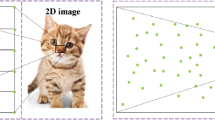Abstract
In this paper, a new point cloud compression method is proposed. The 3D color point cloud is firstly mean-shift clustered into many homogeneous blocks based on the similar spatial (XYZ) information of each point. Based on the RANdom SAmple Consensus (RANSAC) algorithm, those points being clustered in the same block are fitted by a 3D plane and all these points belonging to the same block are projected to this corresponding plane. For every plane an optimal rectangle bounding box is identified and is divided into n × n grids, the color (RGB) information associated with each grid point is replaced by the average of RGB values of all the projected points falling in this grid. Finally, a 2D DCT (Discrete Cosine Transform) transform is performed on these n × n grids points. The compressing ratio can reach 32 with negligible spatial and color distortion.












Similar content being viewed by others
References
Taubin, G., & Rossignac, J. (1998). Geometric compression through topological surgery. ACM Transactions on Graphics, 17(2), 84–115.
Alliez, P., & Desbrun, M. (2001). Valence-driven connectivity encoding for 3D meshes. Computer Graphics Forum, 20(3), 480–489.
Mamou, K., Zaharia, T., & Prêteux, F. (2009). TFAN: a low complexity 3D mesh compression algorithm. Computer Animation and Virtual Worlds, 20(2–3), 343–354.
Kälberer, F., Polthier, K., Reitebuch, U., & Wardetzky, M. (2005). Freelence—coding with free valences. Computer Graphics Forum, 24(3), 469–478.
Touma, C. & Gotsman, C. (1998). Triangle mesh compression. In Proceedings of Graphics Interface (pp. 26–34). Canada: Vancouver.
Courbet, C., & Hudelot, C. (2010). Taylor prediction for mesh geometry compression. Computer Graphics Forum, 30(1), 139–151.
Váša, L., & Brunnett, G. (2013). Exploiting connectivity to improve the tangential part of geometry prediction. IEEE Transactions on Visualization and Computer Graphics, 19(9), 1467–1475.
Zhang, E., Mischaikow, K., & Turk, G. (2005). Feature-based surface parameterization and texture mapping. ACM Transactions on Graphics, 24(1), 1–27.
Yuksel, C., Keyser, J., & House, D. H. (2010). Mesh colors. ACM Transactions on Graphics, 29(2), 1–11.
Fredman, J. H., Bentley, J. L., & Finkel, R. A. (1977). An algorithm for finding best matches in logarithmic expected time. ACM Transactions on Mathematical Software, 3(3), 209–226.
Botsch, M., Wiratanaya, A., & Kobbelt, L. (2002). Efficient high quality rendering of point sampled geometry. In EGRW’02 Eurographics Workshop on Rendering (pp. 53–64). Italy: Pisa
Huang, Y., Peng, J., Kuo, C.-C. J., & Gopi, M. (2006). Octree-based progressive geometry coding of point clouds. In Symposium on Point Based Graphics, SPBG’06 (pp. 103–110).
Comaniciu, D., & Meer, P. (2002). Mean shift: a robust approach toward feature space analysis. IEEE Transactions on Pattern Analysis and Machine Intelligence, 24(5), 603–619.
William, B. & Joan, L. (1993). JPEG: Still image data compression standard. USA, MA: Kluwer Academic Publishers Norwell.
Fukunaga, K., & Hostetler, L. (1975). The estimation of the gradient of a density function, with applications in pattern recognition. IEEE Transactions on Information Theory, 21(1), 32–44.
Georgescu, B., Shimshoni, I., & Meer, P. (2003). Mean shift based clustering in high dimensions: A texture classification example. In Proceedings of the Ninth IEEE International Conference on Computer Vision (pp. 456–463). France: Nice
Qian, X., & Ye, C. (2014). NCC-RANSAC: a fast plane extraction method for 3-D range data segmentation. IEEE Transactions on Cybernetics, 44(12), 2771–2783.
Kammerl, J., Blodow, N., Rusu, R. B., Gedikli, S., Beetz, M., Steinbach, E. (2012). Real-time compression of point cloud streams. In IEEE International Conference on Robotics and Automation (pp. 778–783). MN: Saint Paul.
Yin, R. X., & Siu, W. C. (2001). A new fast algorithm for computing prime-Length DCT through cyclic convolutions. Signal Processing, 81(5), 895–906.
Acknowledgments
This paper is partially supported by the National Nature Science Foundation of China (No.61373084). The National High Technology Research and Development Program of China (863 Program) under Grant No.2013AA01A603-03, the Innovation Program of Shanghai Municipal Education Commission (No.14YZ011).
Author information
Authors and Affiliations
Corresponding author
Rights and permissions
About this article
Cite this article
Zhang, X., Wan, W. & An, X. Clustering and DCT Based Color Point Cloud Compression. J Sign Process Syst 86, 41–49 (2017). https://doi.org/10.1007/s11265-015-1095-0
Received:
Revised:
Accepted:
Published:
Issue Date:
DOI: https://doi.org/10.1007/s11265-015-1095-0





